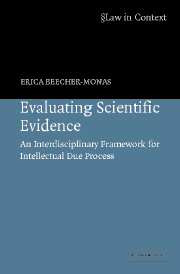Book contents
- Frontmatter
- Contents
- Acknowledgments
- Evaluating Scientific Evidence
- Introduction
- 1 Triers of science
- 2 What is intellectual due process?
- 3 A framework of analysis
- 4 Toxic torts and the causation conundrum
- 5 Criminal identification evidence
- 6 Future dangerousness testimony: The epistemology of prediction
- 7 Barefoot or Daubert? A cognitive perspective on vetting future dangerousness testimony
- 8 Future dangerousness and sexual offenders
- 9 Models of rationality: Evaluating social psychology
- 10 Evaluating battered woman syndrome
- Conclusion
- Index
- The Law in Context Series
8 - Future dangerousness and sexual offenders
Published online by Cambridge University Press: 04 December 2009
- Frontmatter
- Contents
- Acknowledgments
- Evaluating Scientific Evidence
- Introduction
- 1 Triers of science
- 2 What is intellectual due process?
- 3 A framework of analysis
- 4 Toxic torts and the causation conundrum
- 5 Criminal identification evidence
- 6 Future dangerousness testimony: The epistemology of prediction
- 7 Barefoot or Daubert? A cognitive perspective on vetting future dangerousness testimony
- 8 Future dangerousness and sexual offenders
- 9 Models of rationality: Evaluating social psychology
- 10 Evaluating battered woman syndrome
- Conclusion
- Index
- The Law in Context Series
Summary
When it comes to gruesome murders and violent sex offenses, basic rule-of-law precepts appear to be tossed out with the bathwater. Predictions of future dangerousness are not only prevalent in capital sentencing, they also are rampant in post-conviction commitment of sexual offenders. Sexually violent predator acts, enacted in at least sixteen states, uniformly require predictions about the likelihood of reoffending. Predictions of future dangerousness have become routine in the United Kingdom also. These predictions are frequently based on actuarial instruments, but rarely – either in the United States or the United Kingdom – is there any inquiry into their scientific soundness. That these predictions are admitted without serious judicial inquiry into their scientific validity is astonishing in a system that has as a fundamental tenet that only facts having rational probative value should be admissible in the search for truth.
Public pressure for strengthened crime control measures is fed by stories of sexual murders, especially the sexual murders and rapes of children, which occupy the national and international media. Violent recidivism is perceived to be a horrifying reality. The response in the United States as well as the United Kingdom has been an increased emphasis on preventive detention, magnifying the role of future-dangerousness predictions.
Sexually violent predator statutes rely on predictions of dangerousness to commit people who have already served their prison sentences to indefinite terms of confinement.
- Type
- Chapter
- Information
- Evaluating Scientific EvidenceAn Interdisciplinary Framework for Intellectual Due Process, pp. 155 - 167Publisher: Cambridge University PressPrint publication year: 2006

